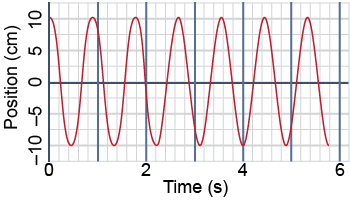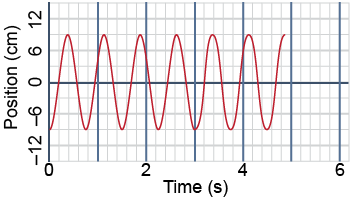 A mass suspended vertically from a spring oscillates with a frequency of 2.3 Hz. The amplitude of oscillation is 10.2 cm. Find the total distance the mass travels in 3.0 s. A mass suspended vertically from a spring oscillates with a frequency of 2.3 Hz. The amplitude of oscillation is 10.2 cm. Find the total distance the mass travels in 3.0 s.

 The graph above represents the motion of an oscillating mass that is suspended vertically from a spring. The graph above represents the motion of an oscillating mass that is suspended vertically from a spring.
- What is the amplitude of the oscillation?
- What is the period of the oscillation?
- What is the frequency of the oscillation?
 While running, a car’s engine might operate around 1,000 revolutions per minute. While running, a car’s engine might operate around 1,000 revolutions per minute.
- What is the engine’s frequency in hertz?
- What is the period of one engine cycle (or revolution)?

 Using the position versus time graph of a harmonic oscillator, find the following: Using the position versus time graph of a harmonic oscillator, find the following:
- the period of oscillation
- the amplitude of oscillation
- the frequency of oscillation
- the frequency of oscillation if the period were halved
 A pendulum has a kinetic energy of 1.6 J at the bottom of its swing. If the mass of the bob on the end of the pendulum is 3.1 kg, what height does the pendulum reach? (Assume that there is no friction.) A pendulum has a kinetic energy of 1.6 J at the bottom of its swing. If the mass of the bob on the end of the pendulum is 3.1 kg, what height does the pendulum reach? (Assume that there is no friction.)
 A 1.8 kg mass oscillates on a spring hanging from the ceiling. If the speed of the mass is 1.4 m/s as it moves through its equilibrium position, what is the potential energy of the system when totally compressed? A 1.8 kg mass oscillates on a spring hanging from the ceiling. If the speed of the mass is 1.4 m/s as it moves through its equilibrium position, what is the potential energy of the system when totally compressed?
| |  A mass of 1.33 kg oscillates at the end of a spring hanging vertically from the ceiling. The frequency of oscillation is 1.2 Hz and the total energy of the system is 0.001 J. Find the oscillator’s amplitude. (Assume that there is no loss due to friction.) A mass of 1.33 kg oscillates at the end of a spring hanging vertically from the ceiling. The frequency of oscillation is 1.2 Hz and the total energy of the system is 0.001 J. Find the oscillator’s amplitude. (Assume that there is no loss due to friction.)

 The graph shows data collected by observing the height of a buoy floating on the ocean over a time interval of 30 s. The graph shows data collected by observing the height of a buoy floating on the ocean over a time interval of 30 s.
- Is this an example of harmonic motion? If so, what are the period and amplitude?
- Had the observations continued, at what time would the buoy have reached its next maximum height?
 A pendulum is oscillating at its natural frequency of 0.7 Hz. If you change the pendulum so that the period is now three times greater, how has the natural frequency changed? A pendulum is oscillating at its natural frequency of 0.7 Hz. If you change the pendulum so that the period is now three times greater, how has the natural frequency changed?
 A 0.75 kg mass on a spring oscillates at 3.1 Hz with a maximum displacement of 8.0 cm. Determine both the maximum velocity of the mass and its total energy. A 0.75 kg mass on a spring oscillates at 3.1 Hz with a maximum displacement of 8.0 cm. Determine both the maximum velocity of the mass and its total energy.
 A 1.3 kg mass on a horizontal, frictionless surface is attached to a spring and oscillates back and forth. Its maximum restoring force is 6.0 N. A similar system has a 2.0 kg mass and experiences a 4.0 N maximum restoring force. Which system has the greatest maximum acceleration? A 1.3 kg mass on a horizontal, frictionless surface is attached to a spring and oscillates back and forth. Its maximum restoring force is 6.0 N. A similar system has a 2.0 kg mass and experiences a 4.0 N maximum restoring force. Which system has the greatest maximum acceleration?
 The period of a rubber band oscillating at resonance is 2.5 s. If the period changes to 3.7 s and the rubber band oscillates at resonance, what happens to the natural frequency? The period of a rubber band oscillating at resonance is 2.5 s. If the period changes to 3.7 s and the rubber band oscillates at resonance, what happens to the natural frequency?
 A mass of 1.6 kg hanging vertically from a spring with k = 175 N/m is pulled by a periodic force with a frequency of 1.4 Hz. Is the system at resonance? A mass of 1.6 kg hanging vertically from a spring with k = 175 N/m is pulled by a periodic force with a frequency of 1.4 Hz. Is the system at resonance?
 A pendulum of length L = 0.22 m is oscillating. A cat swipes at the pendulum with a period of T = 1.3 s. Are the cat’s applied forces resonant with the pendulum? A pendulum of length L = 0.22 m is oscillating. A cat swipes at the pendulum with a period of T = 1.3 s. Are the cat’s applied forces resonant with the pendulum?
 For a given oscillator, the position and acceleration at time t = 3 s are x = 7 cm and a = −0.7 m/s2. Find the frequency of oscillation. For a given oscillator, the position and acceleration at time t = 3 s are x = 7 cm and a = −0.7 m/s2. Find the frequency of oscillation.
|

